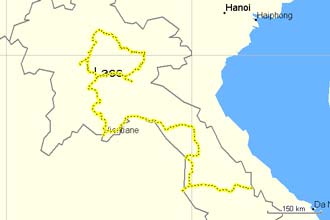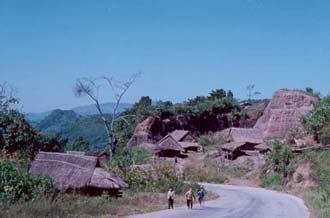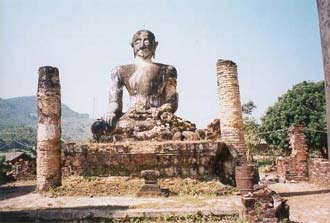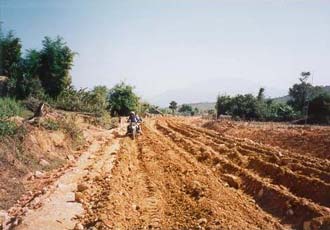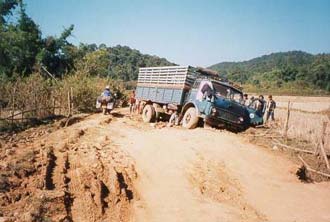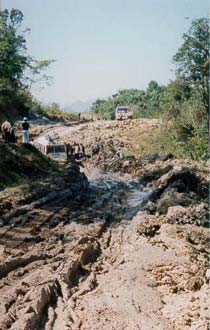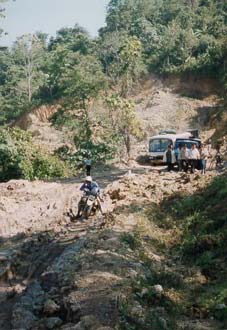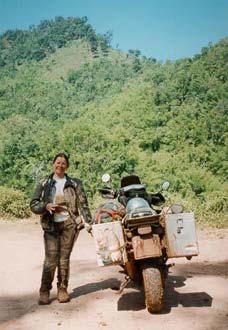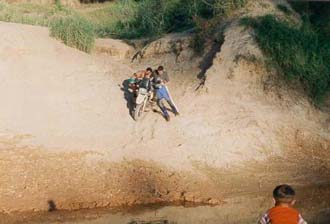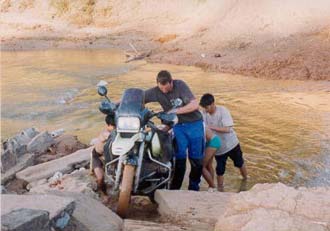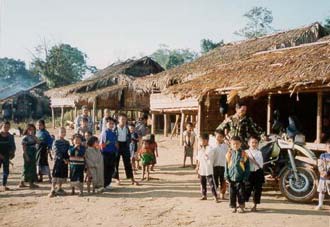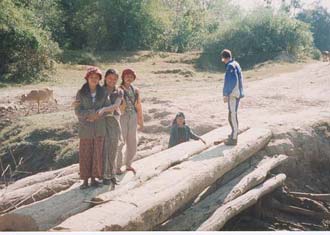Laos - 1
Vientiane (12-11-2001) till Savannakhet (04-12-2001)
Just after the bridge was a traffic light. Here we had to switch lanes to the right side of the road. There was hardly any traffic here but who cares. We parked our bike at the building and were redirected elsewhere. Getting our passport stamped was no problem but the carnet was a different story as we were told that no motorbikes were allowed in Laos! Euh???
Route through Laos; 12-11-2001 / 04-12-2001
But... we could try to get a special permit from the superior officer upstairs. So we went to his office asking if he could fill out our carnet and this was no problem at all. Actually I had to fill the carnet out completely and he was only signing it. The stamp we had to get at the first office where they gave it to us without asking. Now all procedures were completed and we drove to Vientiane, the capital .
Directly you're feeling like driving into another world. Finally you're driving on the right side again but the roads are very bad considering that you were driving to the capital!! Cars are almost non-existent and you see only trucks, busses, pickups and 4WD. Vientiane is a quiet sleeping place especially as a capital, and we spent a couple of days here and enjoyed the French influence. Not only in the colonial buildings but also their baguettes were a real pleasure. We also visited some nice temples and ugly big buildings and memorials of the communist era.
On the road to Luang Prabang we spent one night in Vang Vieng, a place were all backpackers seems make a stop over and there are (almost) only guesthouses, restaurants and Internet places. Not really a great place except for tubing down the river and visit some caves in the area. So we quickly continued the marvellous road towards Luang Prabang.
Typical Laos roadside scenery
This is a great place. Of course also very touristy, but now with reason. Nice temples, palaces and waterfalls. We spent a couple of days here and continued further north. Here the best part of our trip started. We left the touristy places and experienced the real Laos. The roads were few and bad. The further we left Luang Prabang behind, the worse it got. But this was no problem with our overloaded bike as long we kept the speed low. Guesthouses were very few and we spent one night in a small wooden cabin in a village (after another exhausted day). In Ponsavan we visited the 'Plain of Jars', nice to see but not too special. We visited also a nearby village, which was completely bombed during the Vietnam War and enjoyed the big ugly Buddha statue that survived the bombing. This village we actually liked much more.
A Buddha statue that survived the Vietnam war
The road back to civilisation (the main road towards Vientiane) was the worst we had so far: roadwork was going on but about 30 kms. had really bad passages with deep mud tracks. One part was so bad that all non-4WD's got stuck and had to be pulled out by trucks. Jeannette got off to take pictures but I made it through without any help. But a little bit further I misjudged a passage and got stuck.
The 'road' is just ploughed
Jeannette had to help me pushing out but she forgot my earlier warnings not to push directly behind the wheel and got completely covered in mud. I actually wasn't much better and the same for the bike. And worst of all: it wasn't of any use, as we needed the help of a local to get here out! Once we got through, we saw a little bit further drivers removing the mud from their cars. Then we knew that we had made it through the most difficult part and we joined them by removing the mud from our wheels as well, which took us quite a while. The drive back to Vang Vieng was really easy now, and the first thing we had was a good meal and some beer. In the hotel (we were surprised not to be refused because of our mud-look!) we took our well-deserved hot shower and actually we didn't do anything anymore, as we were completely exhausted. The next day we spent the whole day on cleaning the bike and cleaning all our clothes.
Always keep your eyes on the road!
Shiny and bright we left Vang Vieng to return to Vientiane were we arrived... but less than a kilometre from our hotel there were road works going on and to reduce the dust, water was spayed. Therefore the sand turned into mud and.... we fell and could wash our clothes in the hotel again (but it wasn't too bad).
Road to hell?
With two wheels and two feet in the mud
The road from Vientiane to Savannakhet is a boring main road along the Mekong River (although you hardly see the river). So we decided to make a little detour by following highway 8b. The road to Lakxao was amazing going through sharp edged mountain ridges. The road conditions made you driving slowly but this wasn't any problem as there was so much to see around. In Lakxao we had some breakfast, as the interested owner asked us where we were heading. "To Gnommarat" and he directed us back to the road we came from. "No, we think it's this road". He thought for a while and said: "Yes, I think it's possible because you have a motorbike". This should have warned us.
The first 10 km's weren't 'too bad' as the road got unsealed, smaller and muddier. Then we reached the first creek and there was only a very small bridge, which looked quite unstable so we drove through the creek without problems. After some more km's the road narrowed down to a single track only used by small motorbikes. In a very small creek I managed to get the bike stuck into it and we worked for more than half an hour trying to get the bike out, resulting that the bike only moved downwards. We unloaded all luggage and managed to stabilise the bike by putting sticks underneath. Needless to say we both were soaking wet but this was our least concern. As no one passed by Jeannette went out to get some help leaving me behind holding the bike upright.
Never push a bike standing behind the wheel!
After a couple of minutes already, she came back with 3 guys who helped the bike out in no time. We continued the trip through the bush and arrived at a wide river. Fortunately there was a concrete bridge but unfortunately the first section was collapsed. So we had to offload all luggage and bring it to the bridge. Because it was already in the late afternoon people were bathing in the river so there were a lot of spectators but it also meant plenty of help and I certainly needed it.
A controlled descend down to the river
Pushing the bike up on a partly collapsed bridge
With help of three locals we pushed the bike through the soft sand down to the river and through the muddy sand and onto the bridge. So far we had only covered 60 of the 90 km's to Gnommarat and we were afraid of the road ahead of us. But first we spent the night in the village at the river. They provided us an abandoned hut but there was a bed inside. We could only get here beer and sticky rice but together with some of our own supplies we had a good meal. The people were really friendly and in the morning they waved us out after we had only sticky rice for breakfast.
We were the talk of the town
Over the next creek there was a bridge although it consists of only two big logs. In between there was a gap wider than my tire-width so we were looking for smaller logs to fill up this gap. A couple of women helped us finding the right logs, so we could cross this creek as well while Jeannette was holding her breath. Then, very gradually, the track improved and when we finally saw brick houses again we knew that civilisation wasn't far away anymore, and indeed the track turned into a gravel road soon afterwards.
No way to get around this bridge
Bridge improving in progress
When we hit the main road again we were glad we made it and treated ourselves to a big lunch at a local restaurant in Thakek. The next part to Savannakhet was a very smooth ride.
Savannakhet was a nice sleepy French colonial town. Nice to stay here one day but not much longer. So we headed for Lao Bao, the border crossing into Vietnam. The 200 km road, marked as a highway on the map turned out to be a bad gravel road. They were working on the highway almost everywhere but had only finished 30 kms. For the rest we were driving over temporary bypass tracks, which were in a very poor condition. We spent a night in Xepon close to the border and went there the next day. On the Laos side they were very friendly but on the Vietnamese side they stopped us directly and we had to get of the bike and leave the bike over there. They directed me to the Customs building, telling me that when I was able to get a permit for the bike I was allowed to get on the bike again.
Vietnam is a hot issue in motorbike overlanding. Officially it's not allowed to enter the country with a motorbike over 175 cc, so certainly not with mine of 1100 cc. But some people managed to get their bike in. Lots of bikers I had met however had succeeded to get in and now it was my turn. At the border they asked for my special 'bike permit' and I showed them my carnet. They immediately said that it was not valid in Vietnam, as it was not mentioned in the country-list at the back page. But I had added it myself, together with Laos and Cambodia. This was not accepted but then I said that it was legitimate, as the Laos Customs had accepted the addition as well. They were confused and started to call head office and then I knew it was a losing game. The refused to stamp the carnet. We could enter the country but leaving the bike behind. This was not a really attractive option so we returned to Laos.
There they made a problem as we only had a single-entry visa but after some talking they just cancelled our exit-stamp and we were back in Laos. We were so fed up with the Vietnamese unfriendly attitude that we didn't want to enter into Vietnam at all anymore. Another thing was that our friend Erik was flying in to Bangkok within a couple of days and now we were able to meet him in Bangkok soon. So we headed back for Savannakhet following the bad 'road' again, although it didn't seem so bad this time.
We had used our last Lao Kips for filling up the tank again and arrived in Savannakhet just after the banks closed. We tried to get a Thai visa at the consulate as soon as we arrived in Savannakhet. They told us we had to apply for a visa in the morning and pick it up in the afternoon but.... tomorrow was their Kings birthday so they were closed. We explained that we got refused at the Vietnamese border and wanted to enter Thailand as soon as possible. The girl asked if we had pass photos with us. Plenty! So we filled out the application form and paid 600 Baht and got our visa 15 minutes later; an excellent service!!! (You don't need a visa for Thailand but then you get a 30-day permit, with visa it's 60 days).
The banks were closed already and we didn't have any Kips left to pay even our food. But now we had our visa everything was solved immediately as there was no need to stay in Laos anymore so we headed for the car ferry to cross the Mekong River into Thailand. At Customs they didn't know about the carnet and they returned it to me without stamping the bike out. But this was not a problem as it was already stamped out at the Lao Bao border (where they refused to cancel the exit-stamp, which I didn't care at all). Immigration was more difficult as they were confused about the cancelled exit-stamp but after an explanation we got our second exit-stamp and drove on the ferry leaving Laos.

